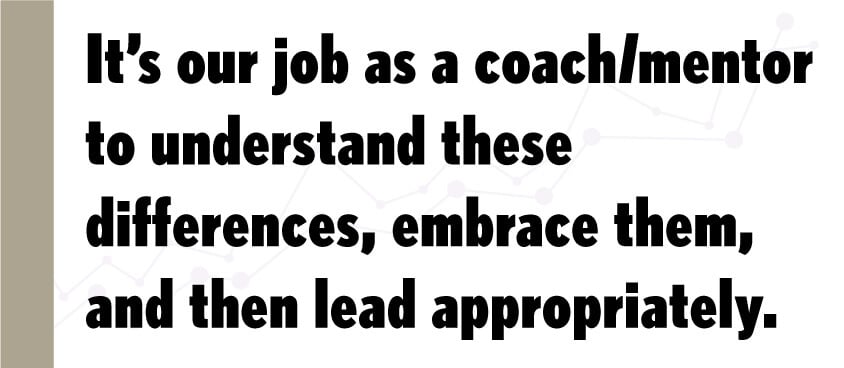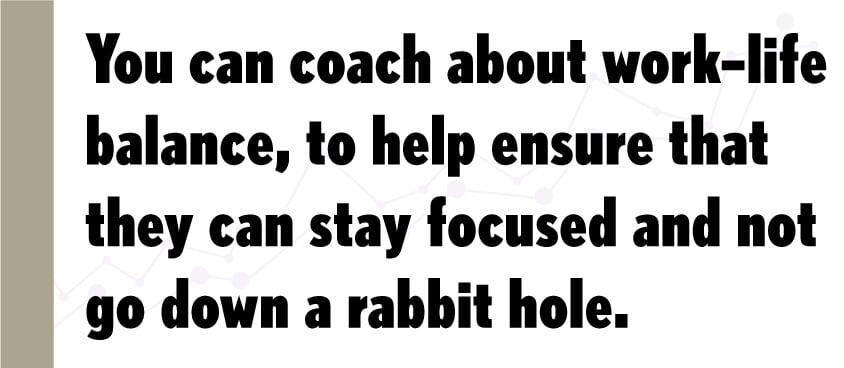Magnificent Manager, Compelling Coach: Leadership’s Two Crowns
Coaching is a crucial function of managing. Every effective leader must be able to do it well. Such is the philosophy of Cherissa Newton, coauthor of the book Coaching for Results and a leadership expert at the Center for Management and Organizational Effectiveness (CMOE). It’s also the view held by many seasoned security managers like David Barton, the chief information security officer at Stellar Cyber, who previously served as director of security for AT&T and corporate security group manager for Sprint over his long management career.
“Hopefully as a leader, you realize sooner rather than later that being a good coach to your team is part of being a good manager,” Barton says. “You can’t have one without the other.”
What differentiates coaching from managing? As Newton defines the concepts in a recent CMOE analysis, managing often involves day-to-day tasks like conducting meetings, assigning tasks, making departmentwide decisions, and dealing with staff conflicts.
Coaching, on the other hand, is defined by Newton as “a two-way communication process between different members of the organization aimed at influencing and developing the employees’ skills, motivation, attitude, judgment, ability to perform, and willingness to contribute to an organization’s goals.”
Both are crucial to effective leadership. According to Newton, the benefits of adding coaching to your management style can include enhanced performance, improved productivity, higher employee engagement and retention rates, and a stronger culture of trust in the workplace.

A Two-Way Street
The coaching definition’s opening phrase, “a two-way communication process,” is one of the most crucial aspects of coaching, according to veteran managers like John Torres, head of the security and technology consulting practice at Guidepost. Torres has more than 27 years of experience in federal investigative and security management for agencies such as the U.S. Department of Homeland Security (DHS). As an acting director for U.S. Immigration and Customs Enforcement (ICE) from 2008 to 2009, he oversaw 20,000 employees and a $5 billion budget.
Torres says that working on many different teams early in his career gave him an opportunity to observe “good bosses and bad bosses.” Bad managers, he says, usually acted as the self-styled “smartest guys in the room.”
“They were like, ‘This is how it’s done,’ and there was no room for questions, even when you often knew there were other ways to do it,” Torres explains.

In contrast, good managers always maintained two-way communication—even when they knew that they were the smartest person in the room, he says. Those managers did not let their high knowledge level preclude them from being open to other opinions. “They had the ability to communicate and to listen,” Torres says.
And two-way communication helps enfranchise an employee, which can significantly boost engagement and retention, Barton says.
“Team members want to feel that they have a say in the direction of the team and how that relates to the overall direction of the company,” Barton says. “Lacking a two-way approach, communications feel dictatorial, and not team-orientated. Team members want to know they make a difference.”
And team members also want to know what is expected of them, says Chris Stowell, one of the coaching experts at the CMOE. “They want an opportunity to do their best work every day,” he says. Coaching facilitates this; it allows for productive two-way discussions about expectations, results, and suggestions on how to enhance performance. “We may not always like what we hear, but ultimately, we want to do better, be better,” he adds.

Not One-Size-Fits-All
Good coaching effectively addresses a truism that holds at every workplace, experts say: each employee is a unique individual.
That means that learning styles, productivity levels, workload tolerance, and preferred means of recognition differ from staffer to staffer. Sometimes the differences are slight; sometimes they are staggering. But one-size-fits-all management is not the most effective way to help employees fulfill their individual potential or maximize their contributions to the organization.
“Each person learns differently and thrives under different management styles. It’s our job as a coach/mentor to understand these differences, embrace them, and then lead appropriately,” Barton explains.
In one of his previous security positions, Barton suspected that a team member was in the wrong role. After a few weeks of observation and directed questions, Barton made a realization.
“This person was not driven by technology—something essential for an engineer—but rather by people. So I spent a few days with this person discussing my perspective—only for them to agree (after I assured them their job was secure),” Barton says. “I then reached out to some of my peer leaders who led customer-
facing teams and helped my team member move to the other department. They thrived and became a great contributor to our company.”
Individual coaching proved useful for Torres when he was in federal law enforcement, managing a certain type of young idealistic federal agent who did not like to say “no” to any assignment. Soon that agent was “working around the clock.”
Torres was able to coach the agent about the importance of not taking on a workload that would greatly increase the risk of burnout. “You can coach about work–life balance, to help ensure that they can stay focused and not go down a rabbit hole,” he explains.
Learning about the individual employee is especially important when it comes to another crucial aspect of coaching: recognition. “Recognizing a staffer’s accomplishments plays a significant role in coaching,” Barton says.
“For accomplishments you see daily or weekly, acknowledge them! Part of your role as a manager is to see growth, even small steps, from someone on your team,” he continues. “It is pretty easy to throw out a ‘well done’ via email, Slack, or text.”
Stowell adds that coaching, which regularly recognizes accomplishments, does wonders for staff retention. “That’s very critical to ensuring that you can keep successful employees,” he says. But here again, the individual needs of staffers matter. “Everyone is different,” Stowell says. “Different people have different levels of recognition requirements, so to speak.”
Thus, some employees prefer one-on-one acknowledgment of accomplishments, while some like more public recognition. In terms of rewards, some prefer material assets like gift certificates, raises, or bonuses, while others like work–life balance enhancements like extra time off or vacation time.
“Team members are motivated by different things, such as money, public recognition, or promotions,” Barton says. “The manager also needs to think about reactions from the team and from other peer managers. Bigger organizations have processes for promotions, so it’s best to work with HR to ensure your promoted employee’s experience is done right.”
In addition, a particularly potent form of recognition in coaching is one that cites the details of the accomplishment—details that might have been missed by others but which are noticed by the appreciative manager.
“Noticing the details is a powerful tool. I develop a sense of how my team wants feedback, and I also show them I notice the details,” Barton says. “This is important if you want people to think they can learn from you.”
Trust Building
Coaching that recognizes details and serves as a learning tool for employees builds trust within the organization.
How can managers increase their chances that they will build trust through their coaching? First off, it should be proactive rather than reactive coaching, Stowell says. To be more proactive, a manager can make coaching part of a daily routine and be ready to take advantage of small issues and developments as coaching opportunities aimed at elevating performance. This is especially effective in ensuring that coaching does not devolve into a reactive series of corrective conversations when things go wrong, he says.
Of course, there are times when coaching needs to be corrective, but there are ways a manager can do this without discouraging the employee.

“First, I think it is key to make sure you do it in private—shaming people does not build loyalty with your performers. That only builds fear and mistrust, and potentially your own team will start to throw others under the bus,” Barton says. “It can spiral.”
But learning this lesson can be difficult for new security managers, who may sometimes be feeling the pressure of a high-stress situation when trying to correct a staffer’s mistake, Torres says. “Often, that’s not something they teach you early on in your career,” he explains. “And in a heated moment, you can say the wrong thing.”
Given this, it often helps to adopt a measured mind-set so that heated moments can be avoided. It behooves a manager to dispassionately diagnose the root cause of the mistake, Torres explains. Was the mistake purely an issue of employee judgment? Or are there underlying policies and operating procedures that are creating vulnerabilities? Or is it a case of an overworked employee who is making more mistakes due to fatigue? “You take the attitude of, ‘How can we help you do this better?’” Torres says.
Overall, this type of mindful coaching, which focuses not on the mistake but on stronger future results, shows that the manager cares about the staffer, and that also helps build trust. “Everyone wants coaching to some extent, because coaching is an investment. People want to know you care enough to invest in their success and coach them through their failures,” Barton explains.

Be Coachable
In his work as a coaching consultant for CMOE, Stowell has noticed a few recent trends among leaders who are considered successful coaches, and he shared practices that other leaders who aspire to improve as coaches could benefit from.
One is “coaching on the fly,” which is more likely to take place in a workplace that is also a fast-moving production environment, or one that is that is highly matrixed. In some of these types of organizations, managers are increasingly prepared to do “quick hits” of brief developmental conversations that have value for both participants. And although they are short, these brief coaching episodes can still take preparation on the manager’s part, Stowell says.
In Barton’s view, many fast-moving security workplaces could benefit from some coaching on the fly. “Coaching is a just-in-time response, as well as a thoughtful planned activity. A good leader has to be prepared for both approaches and take into account the situation, the team member, and the coaching needed,” Barton says.
Another trend is coaching across teams, Stowell says. In many organizations, cross-functional teams are becoming more popular as a means of breaking down silos and soliciting a wide range of ideas and viewpoints. This gives team members and team leaders the opportunity to coach other members and leaders, even if the managers have no formal leadership authority over the coworkers they are coaching.
However, in cases where there is no formal leadership authority, it can help if the coach is “a little bit provisional” in approaching the conversation, Stowell explains. So instead of saying something like “you did this wrong, please fix it,” the team member may offer “an observation around security such as ‘from my perspective, here’s what I am seeing, and here’s what the potential risk is.’ You’re bringing them into the conversation,” Stowell says.
In the end, experts like Stowell say that everyone in an organization should be both coachable and a potential coach, whether they are a new employee or a manager, a line worker or a senior executive, young or old, experienced or new.
“I should be able coach my leader and say, ‘From my perspective, here’s some feedback and insight,’” Stowell says.
Torres has seen the importance of this throughout his career. Back in the day, when federal agencies were using computer banks, Torres remembers some older agents who badly needed technological coaching from younger employees. “They were deathly afraid of going near the computer. They were happy to be working on an old typewriter,” he says.
Now, in the era of high-definition cameras and social media saturation, Torres takes advantage of the younger expertise in his senior role at Guidepost. “I continue to be coached by the younger generation,” he says.
The future may hold even more challenges, such as coaching in virtual environments as organizations employ more remote teams and video conferences, Stowell says. In such situations, he recommends coaches do regular checks for understanding, such as asking staffers to briefly summarize information that was just conveyed, and be especially mindful of their tone of voice. “There are more opportunities for misinterpretations,” he says.
Mark Tarallo is senior content manager for Security Management. Contact him at [email protected] and connect with him on LinkedIn.
